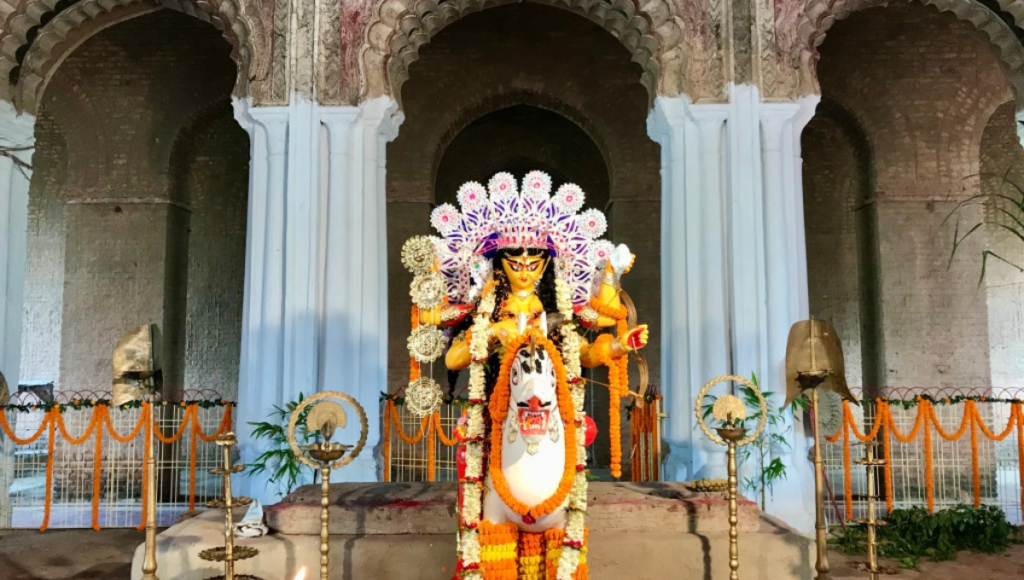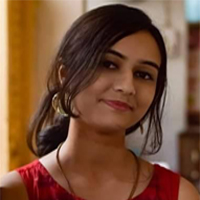Jagadhatri Puja, a beloved festival in Bengal, follows in the footsteps of the grand Durga, Lakshmi, and Kali Pujas, taking place during the month of Kartik. Often referred to as another form of Durga, Jagadhatri – meaning “Holder of the World” in Sanskrit, Bengali, and Assamese – embodies a divine balance of courage and sustenance. This festival has its roots in the unique synthesis of Tantra, where Jagadhatri, symbolizing “sattva” (purity and equilibrium), is positioned alongside Durga and Kali, who represent “rajas” (passion) and “tamas” (darkness), respectively.
Legend and Origins of Jagadhatri Puja Tradition
One legend attributes the origins of Jagadhatri Puja to Raja Krishnachandra Ray of Krishnanagar in the 18th century. According to this tale, Krishnachandra was once imprisoned by Siraj-ud-Daula for failing to pay taxes. While returning home by boat after his release, he was saddened to learn he had missed Durga Puja. That night, he had a divine vision of the goddess Durga as a young child, instructing him to worship her in a new form on the ninth day of Kartik’s bright fortnight. This form, his priest revealed, was Jagadhatri. To honor her instructions, Krishnachandra commissioned an artist to create the first Jagadhatri idol, sparking a tradition that continues in Krishnanagar Rajbari to this day.
Yet, the worship of Jagadhatri might predate this legend. Historians argue that her cult has distinct tantric associations, tracing back to Krishnananda Agamavagisha’s Tantrashastra, a 16th-century work that describes Jagadhatri’s imposing figure. She rides a lion and subdues an elephant demon, symbolizing pride subdued by divine wisdom. With her four arms, holding conch, discus, bow, and arrows, adorned in red and with a snake as a sacred thread, Jagadhatri is a striking form, meant to inspire humility and courage in her devotees.
Chandannagar: Heart of Grand Jagadhatri Puja Festivities
Chandannagar, a former French colony in Hooghly district, has become the epicenter of Jagadhatri Puja celebrations. While Krishnanagar holds historical significance, Chandannagar now boasts unmatched grandeur, drawing crowds for its spectacular light displays. During the four days of festivities, the town transforms, with pandals, food stalls, and dazzling artwork adorning the streets. The highlight comes on Dashami, the final day, when a grand procession of idols winds through the town in a night-long journey, showcasing Chandannagar’s famous artistic flair in intricate light displays. This procession is more than a mere festival; it’s a homecoming for countless locals who return to Chandannagar to celebrate together, creating an atmosphere of warmth and unity.
In Chandannagar, it’s said that Indranarayan Chowdhury, a wealthy patron, was the first to organize Jagadhatri Puja in the 1750s, influenced by his encounters with Raja Krishnachandra. Despite Chandannagar being under French control, the local French community supported the festival. This integration created a unique cultural fusion where both French and Bengali traditions came together, adding to the charm of the festival. Even today, the people of Chandannagar take pride in this heritage, celebrating Jagadhatri Puja as their annual main event, often outshining Durga Puja.
Also Read: The Essence Of Jagadhatri Puja And Celebrations Amidst COVID-19
Jagadhatri: The Humble Goddess Who Conquers Pride
The mythology of Jagadhatri has intriguing twists. One lesser-known story suggests that after Durga’s victory over the demon Mahishasura, she became prideful, which displeased the gods who had created her from their collective powers. To humble her, Brahma, Vishnu, and Shiva created Jagadhatri, a new goddess with a calm demeanor. In one tale, Jagadhatri’s encounter with the elephant demon Karindrasura represents the triumph of wisdom over arrogance – a reminder that even the strongest must remain humble. This symbolism is central to Jagadhatri Puja, as devotees worship her as both a destroyer of pride and a sustainer of peace.
Another version of the story recounts Jagadhatri’s transformation during her battle with the demon Karindrasura, who had taken the form of a giant elephant to confuse her. In response, Jagadhatri appeared with her iconic lion, holding a deadly discus that eventually vanquished the demon. The symbolism here is profound: the goddess’s divine power defeats the elephant, a representation of pride, illustrating the importance of humility in the face of arrogance.
The Jagadhatri idol itself reflects a striking visual identity, distinct from Durga’s. Jagadhatri’s face is long and narrow, with wide, expressive eyes that extend to her ears. Artisans craft her attire and ornaments meticulously, with a beautiful backdrop made of sola (a lightweight pith material) and mats painted with intricate designs. They have preserved this traditional style over centuries, particularly in Chandannagar, where each year they dedicate themselves to making her idol more magnificent than ever.
Also Read: Shyamasree Samman 2020
Traditional Rituals and Customs of Jagadhatri Puja
The rituals of Jagadhatri Puja reflect the blend of tradition and devotion. At many pandals, animal sacrifices are still conducted, with goats offered on the ninth day as a symbol of Bali (sacrifice) to appease the goddess. It’s also notable that in some parts of Chandannagar, only men can participate in certain rituals, adhering to customs passed down through generations.
Conclusion:
The Jagadhatri Puja is more than just a festival; it is a spiritual journey for many, symbolizing the fight against ego and the embrace of wisdom. Jagadhatri serves as a divine reminder that true strength lies in humility and perseverance. As the goddess who holds the world, Jagadhatri reassures her devotees that despite life’s chaos, a balanced spirit can sustain and overcome all challenges.





One Response